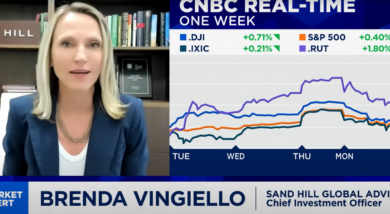Evergreen funds, also known as open-ended, semi-liquid, or perpetual vehicles, are transforming the private market landscape by offering a more accessible, flexible alternative to traditional

Having Patience to Persevere
October 25, 2022
As financial markets continue to deliver volatile and negative returns this year, it certainly feels like one of the biggest tests of patience we have collectively felt in a very long time. To make matters worse, there are many significant economic contradictions that exist right now that only add to this heightened level of confusion, frustration, and anxiety.
The stock and bond markets, as represented by the S&P 500 and the Aggregate Bond Benchmark, are down almost 20% and 15% respectively year to date through September 30th and are acting as though a recession is just around the corner. Meanwhile, the job market continues to enjoy one of its strongest periods in history, and the manufacturing and services industries continue to expand. But measures of consumer sentiment are at lows they haven’t experienced since the Financial Crisis, even though jobs are plentiful and household net worth is near all-time highs. And then there’s inflation, which is on everyone’s mind—we are all feeling it, and no one is happy about it. And most of the current generation of investors has never invested through a period of high inflation and rising interest rates, and this further compounds the angst and uncertainty. So, what’s an investor to do? History tells us that these types of severe market dislocations don’t come around very often (thankfully!) and when they do, they typically represent a compelling long-term investment opportunity—although this is always much clearer in hindsight than in the moment. As the famous investor Shelby Davis once said, “You make most of your money in a bear market, you just don’t realize it at the time.”
Since 1950, the S&P 500 has declined 25% or more from peak to trough just nine times, including the current correction. Unfortunately for us right now, two of these nine dislocations have happened within the last three years, and this is likely why we are all feeling less sanguine than we might otherwise normally be. Nevertheless, within one year of being down 25%, the market delivered a positive one-year return in all but one of these historic periods (the extraordinary credit crisis of 2008 being the lone exception); and within three years, the market was positive in all instances.
The bond market is also currently experiencing a historic decline with rates rising at their fastest pace in 40 years. The resulting price decline has been especially troubling given this asset class’s historic nature of preserving capital. Yet, this recent decline has also created an attractive investment opportunity. We have recently been reducing exposure to the absolute return allocation in your portfolio and using the proceeds to invest in bonds. This is the first time in many years that we have increased exposure to this asset class. In our view, bonds should soon resume their protective role, particularly in a recessionary environment when yields would likely decline, causing bond prices to rise.
Additionally, yields on money market funds and short-term bonds have increased dramatically this year and this outcome has presented savers with a new and compelling alternative to keeping cash in traditional bank checking and savings accounts where yields remain relatively low (since banks’ very reason for existing is to make a profit on the differential between what they lend versus what they pay on deposits). Even though rates on short-term Treasuries—which are around 4% as of this writing in mid-October—are lower than the overall rate of inflation, they still represent an attractive way to generate a little bit of additional yield that is exempt from state and local tax. For those wanting daily liquidity, position-traded money market funds are now yielding almost 3%.
And yet, while yields on cash and cash equivalents are finally pretty enticing, we believe stocks and bonds present a much more attractive opportunity over the next twelve months. Of course, the biggest question on everyone’s mind is how much longer stocks and bonds will remain depressed and how much more downside there could be from current levels. In our view, we are most of the way through the painful part of this correction. Even though inflation—as measured by the Consumer Price Index (CPI)—has remained stubbornly high, many other measures including commodity prices and business surveys of both the manufacturing and services industries are suggesting that input prices are coming down. Wages, on the other hand, continue to grow, but the pace of their growth has slowed. We expect that these lower overall costs will eventually make their way to consumer prices, particularly if demand begins to soften.
The valuation of the stock market has come down significantly from its high and is now below historical averages. We believe stocks are effectively discounting a “hard-landing” (aka recessionary) scenario where corporate earnings would likely contract at a double-digit pace. This is especially true in small and mid-cap stocks where valuations are at historic lows. International stocks are also trading at very depressed levels and are essentially pricing in recession.
We have been underweight in bonds for a long time, but that has recently changed over the last two quarters. Yields on one and two-year Treasury bonds are now pricing in the actions that the Federal Reserve is expected to take over the next two years. This should result in less volatility for this part of that asset class, and of course, greater yields than investors have been able to achieve for most of the last decade.
As we assess the environment going forward, there is clearly lots of uncertainty, and no one knows when stock and bond prices will finally begin to meaningfully recover. Still, if we look back historically, the stock market has typically made lows when times were very uncertain. In late March of 2020, the market began to recover, although we were still at the very beginning of a serious and worrisome pandemic environment that no one had ever lived or invested through. Back in early March of 2009, the economy was still an absolute disaster, yet trends had started to become a little “less worse” and this was enough to cause a powerful recovery over the subsequent quarters and years. As long-term investors (and stewards of your wealth), our objective is to take advantage of opportunities like the one being presented today. Staying invested—and constantly rebalancing—is a crucial part of being able to participate in the eventual recovery which typically happens quickly and in the face of continued uncertainty. We value our partnership with you and encourage you to reach out to your Wealth Manager if you would like to have a more in-depth review of our economic outlook and your personal financial plan.
Articles and Commentary
Information provided in written articles are for informational purposes only and should not be considered investment advice. There is a risk of loss from investments in securities, including the risk of loss of principal. The information contained herein reflects Sand Hill Global Advisors' (“SHGA”) views as of the date of publication. Such views are subject to change at any time without notice due to changes in market or economic conditions and may not necessarily come to pass. SHGA does not provide tax or legal advice. To the extent that any material herein concerns tax or legal matters, such information is not intended to be solely relied upon nor used for the purpose of making tax and/or legal decisions without first seeking independent advice from a tax and/or legal professional. SHGA has obtained the information provided herein from various third party sources believed to be reliable but such information is not guaranteed. Certain links in this site connect to other websites maintained by third parties over whom SHGA has no control. SHGA makes no representations as to the accuracy or any other aspect of information contained in other Web Sites. Any forward looking statements or forecasts are based on assumptions and actual results are expected to vary from any such statements or forecasts. No reliance should be placed on any such statements or forecasts when making any investment decision. SHGA is not responsible for the consequences of any decisions or actions taken as a result of information provided in this presentation and does not warrant or guarantee the accuracy or completeness of this information. No part of this material may be (i) copied, photocopied, or duplicated in any form, by any means, or (ii) redistributed without the prior written consent of SHGA.
Video Presentations
All video presentations discuss certain investment products and/or securities and are being provided for informational purposes only, and should not be considered, and is not, investment, financial planning, tax or legal advice; nor is it a recommendation to buy or sell any securities. Investing in securities involves varying degrees of risk, and there can be no assurance that any specific investment will be profitable or suitable for a particular client’s financial situation or risk tolerance. Past performance is not a guarantee of future returns. Individual performance results will vary. The opinions expressed in the video reflect Sand Hill Global Advisor’s (“SHGA”) or Brenda Vingiello’s (as applicable) views as of the date of the video. Such views are subject to change at any point without notice. Any comments, opinions, or recommendations made by any host or other guest not affiliated with SHGA in this video do not necessarily reflect the views of SHGA, and non-SHGA persons appearing in this video do not fall under the supervisory purview of SHGA. You should not treat any opinion expressed by SHGA or Ms. Vingiello as a specific inducement to make a particular investment or follow a particular strategy, but only as an expression of general opinion. Nothing presented herein is or is intended to constitute investment advice, and no investment decision should be made based solely on any information provided on this video. There is a risk of loss from an investment in securities, including the risk of loss of principal. Neither SHGA nor Ms. Vingiello guarantees any specific outcome or profit. Any forward-looking statements or forecasts contained in the video are based on assumptions and actual results may vary from any such statements or forecasts. SHGA or one of its employees may have a position in the securities discussed and may purchase or sell such securities from time to time. Some of the information in this video has been obtained from third party sources. While SHGA believes such third-party information is reliable, SHGA does not guarantee its accuracy, timeliness or completeness. SHGA encourages you to consult with a professional financial advisor prior to making any investment decision.








